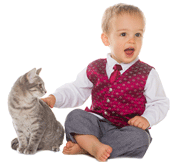Cats and Kids
Here are some guidelines to help your children and your new cat live happily together:
 Instruct children to be calm, quiet, and slow moving when being introduced to the cat.
Instruct children to be calm, quiet, and slow moving when being introduced to the cat. - A kitten or cat should be picked up and held with one hand under its chest and the other hand supporting its hindquarters.
- Handle the cat gently and tell children not to squeeze or hold too tightly. Most children under the age of 5 cannot hold a cat properly without squeezing too tight.
- Young children should be taught to sit calmly while you place the cat in their laps. This way everyone is safe and happy.
- Children should leave the cat alone when he is sleeping, eating and using the litter box. Also, instruct youngsters not to put the cat in inappropriate places like the dryer, on the top bunk, in a closed box, etc.
- Cats should not be dragged out of hiding against their will.
- Children should not chase the cat around the house.
- If cornered and frightened, the cat may scratch and bite or may become timid.
- Never leave young children alone with a new pet.
- Teach children appropriate play and petting. Do not allow them to encourage the cat to bite them or run after them. The children should not BE the toys. Provide safe toys for both the cat and the kids.All interactions between cats and children should be carefully supervised.
- Teach children to look for signals that show their pet is getting irritated or over-stimulated. A swishing tail, ears back or gentle nips can lead to being scratched or bitten.
- Always allow the cat to escape if he tries to run. If the cat struggles to get away, let him go!
- Never allow rough handling, as this teaches the cat that it is OK to be rough in return!
